#phylum final round
Text
Phylum Final Round!

For the Phylum Level Champion!
Reminder: This is the final PHYLUM round. Winner goes on to classes!
Magnoliophyta (aka angiosperms, flowering plants): A large, diverse phylum with over 300,000 known species. Two of the more well-known sub-divisions are monocots (including grains, onion-like plants, and irises and lilies) and eudicots (including most leafy trees, a wide variety of flowers such as sunflowers and roses, and many food plants from coffee to cabbages.)
Bryophyta (aka mosses): Small but mighty, and among the most ancient of land plants. 95% of all moss species are in the class Bryopsida, while Sphagnopsida contains the bog-loving peat mosses.
#magnoliophyta#bryophyta#plant taxonomy showdown#battle of the plants#phylum final round#phylum#plant bracket#tumblr bracket#bracket tournament#poll bracket
485 notes
·
View notes
Text
Wet Beast Wednesday: tardigrades
Last week on Wet Beast Wednesday I covered the largest animals to ever exist on our planet. This week I'm going to pull a full 180 and cover the smallest animals yet on this series. Meet the tardigrade, the internet's favorite micro-animal the is said to be basically immortal. How true is that? Let's see.

(Image: an electron microscope image of a tardigrade. It looks a lot like a potato with eight stubby legs tipped with long claws. At the front is a small, circular mouth. It has no other discernable features. In the background are bits of plant matter that look like seaweed at this scale. End ID)
The tardigrades are 1,300 known species (and probably a lot of unknown ones too) in the phylum Tardigrada. They are also part of the superphylum Ecdysozoa, which are animals that grow by molting their outer cuticles or exoskeletons. In particular, the tardigrades are believed to be a sister group of the arthropods, the group that contains crustaceans, insects, isopods, and a lot of other things. Tardigrades are truly tiny, the largest species reaching a whopping 1.5 millimeters in length, though most species reach no more than 0.5 mm. They have round, segmented bodies with four pairs of legs that end in either claws or suction discs. The body segments consist of a head, three body segments with a pair of legs each, and a caudal segment with the final pair of legs. The first three legs are used for movement while the final pair points backwards and is used for grabbing onto substrate. All of the body segments except for the final one correspond to segments found in the head section of insects. Tardigrades are missing many hox genes, genes that direct the body plan during development. Their ancestors may have had a body plan more similar to insects, but the loss of the hox genes has compressed them into walking heads with a bit of butt. The mouth is tubular and sucks in food. In the mouth are stylets, needle-like structures used to pierce food objects. Once food is drawn into the mouth, a structure called the buccopharyngeal apparatus activates. This is a combination of spines and muscle that acts like an inner jaw that pulls food into the digestive tract. The buccopharyngeal apparatus is distinct enough to be used as a major identifying feature between species. Tardigrades are translucent and many images you've seen of them have false color to show the details or are 3D models based on scanning electron microscope imagery of them. Tardigrades molt their exoskeletons multiple times (up to 12) during their lifecycle. Some species are unable to poop normally and instead all their waste is discarded during the molt. It was formerly believed that tardigrades could exchange genes with each other without mating, a process called horizontal gene transfer that is seen in bacteria, archaea, and other micro-organisms. It has since been discovered that while still capable of horizontal gene transfer, it is quite a bit rarer in tardigrades than we thought.
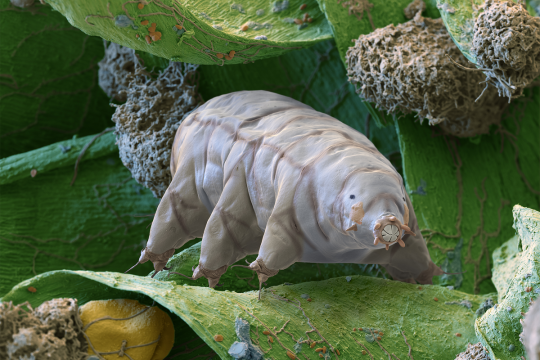
(Image: an electron microscope image of a tardigrade standing on a bit of plant matter. This one has a closed mouth with a ring of triangular tooth-like structures. It also has two simple eyes that look like black dots. End ID)
The name "tardigrade" means "slow walker", which is fitting as, despite their eight legs, tardigrades have a slow and awkward gait. This is the result of their legs being unjointed, only able to pivot at their connection to the body. Their gait has been compared to that of bears, hence why they are often called water bears and their discoverer, Johann August Ephraim Goeze, called them "kleiner wasserbär", meaning "little water bear". Tardigrades are found worldwide and have inhabited virtually every habitat, from the tops of mountains to the deep sea, from hot springs to the antarctic, from freshwater to saltwater. The one thing they have in common is a need to stay wet. Tardigrades can survive out of water as long as they can stay moist and are often found in mosses, hence another common name: moss piglets. The majority either eat plants or bacteria, but some will feed on smaller tardigrades or other micro-animals. Their famous survivability makes it easy for tardigrades or their eggs to be carried to new habitats by larger animals or other phenomena. Tardigrades are one of the first micro-animals to colonize a new habitat and they are a pioneer species, the first species to colonize a new environment and whose presence makes that environment fore suitable for other species to follow. Tardigrades are a major food source to other micro-animals and larger organisms. Most species have distinct males and females, though a few reproduce through parthenogenesis. In most cases, molting female will lay her eggs in her shed cuticle and males will them fertilize them. Other species have a form of internal reproduction. Males and females will court each other before mating and females will usually allow multiple males to fertilize her eggs. Female tardigrades are typically larger and more abundant than males. Eggs can take up to 14 days (species dependent) before hatching. All tardigrades of the same species have the exact same number of cells as each other. They are also born with the same number of cells they will have as an adult. Their growth is driven by enlargement of the existing cells rather than cellular reproduction making new cells. The lifespan ranges between a few months to a few years, depending on species.

(Image: a color photo of a tardigrade. It is a pale, translucent white, making it hard to make out details. Its body is curved, with the front end pointing at the camera. It has two simple eyes. End ID)
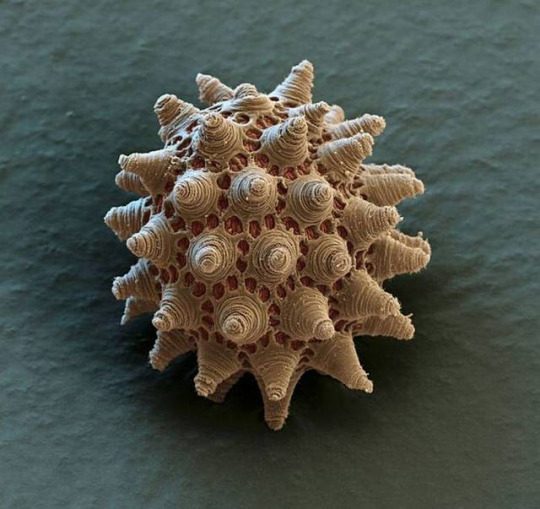
(Image: an electron microscope image of a tardigrade egg. It is round but covered in small pores and conical structures. End ID)
The most famous feature of tardigrades is their legendary durability. It is commonly said that tardigrades can survive just about anything (except for the things that are actually trying to kill them. They are prey to a lot of species after all). Among the things they can survive is extreme heat, extreme cold, dehydration, extremely high and low pressure, exposure to ionizing radiation (that's the scary kind), low oxygen environments, environmental toxins, heavy impacts, and the vacuum of fucking space. While the can survive in extreme conditions, tardigrades are not considered extremophiles. True extremophiles thrive in extreme environments and are negatively impacted by leaving them. Tardigrades can survive in extreme environments, but are negatively impacted and can't survive as well there as they can in less extreme places. The main trait that has allowed tardigrades to survive all five mass extinctions in history is cryptobiosis. Cryptobiosis is the rare ability for an animal to enter a state of dormancy where their metabolic processes come to an almost complete stop. While in cryptobiosis, metabolic activity drops to 0.01% normal and water content drops to 1% normal. In this state, the tardigrade is called a tun. Tardigrades usually enter cryptobiosis in response to arid conditions. One experiment showed that a species of tardigrade could last for at least 30 years in this state and return to normal lifestyle functions when exposed to water. Tardigrades will also enter cryptobiosis in response to low oxygen, toxic chemical exposure, increased or decreased temperature, and excessive salt content in the water. Tardigrades also show extreme resistance to both high and low pressure. They can live in 0 atmospheres of pressure and some species can survive up to 6,000 atmospheres, more than double the pressure at the bottom of the Marianas trench. More interesting is their ability to survive dangerous radiation. They can survive 1,000 times the dose of gamma radiation that humans can. Early tests focused on tardigrades in cryptobiosis and concluded that the extremely low water content of a cryptobiotic tardigrade doesn't leave much opportunity for the radiation to react with the animal. However it was later found that active and fully hydrated tardigrades are still considerably resistant to radiation. Studies into this resistance indicate that tardigrades can very efficiently repair damaged DNA and have unique proteins called Dsup that provides additional protection. Dsup introduced to human cells has provided additional protection against x-rays.
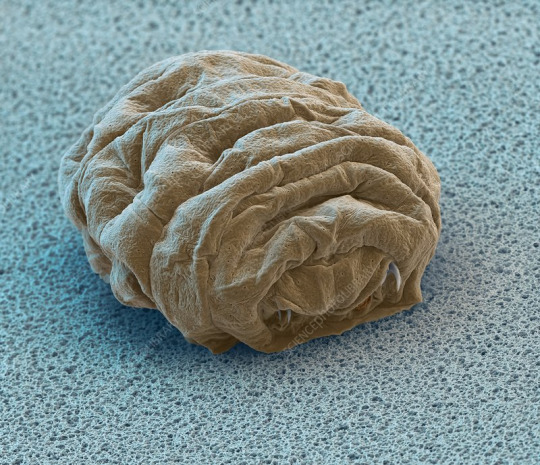
(Image: an electron microscope image of a tun - a tardigrade in cryptobiosis. It is smaller and very wrinkly, with the legs and mouth retracted into the body. End ID)
Tardigrades were the first animals to be exposed to the vacuum of space. They were exposed for 10 days, some in a state of cryptobiosis at the time of exposure and some still active. It was found that they were able to survive the vacuum when shielded from the sun's ultraviolet radiation, with those already in cryptobiosis doing better. Upon being rehydrated, many were able to resume normal life functions and successfully reproduce, though others died after being rehydrated. Those that were exposed to UV radiation fared much worse, with only a few hydrated individuals surviving. The individuals in cryptobiosis had a lower survival rate when exposed to UV than those not exposed to UV and were less successful at reproducing afterwards. Studies of tardigrade's space survival abilities and resistance to radiation could go a long way in helping human space travel. One of the largest dangers of space travel is that space is full of nasty radiation from the sun that Earth's magnetic field protects us from. Some scientists speculate about the possibility of accidentally seeding other planets or moons with tardigrades or other space-resistant organisms. This is a problem because introducing Earth life to other world has the potential to damage any native ecosystems and if we find life in space in the future we don't want to have to figure out if it's something we accidentally put there. While tardigrades could likely survive on other planets, they would eventually die without a food source. Some sources reported that tardigrades may have colonized the moon after an experiment with them crashed. Unfortunately, the moon is not crawling with tardigrades now. It's way too dry for them to exit cryptobiosis even if they survived the crash, which they probably didn't.
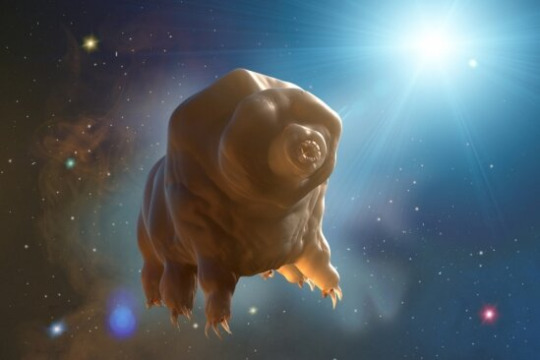
(Image: art of a tardigrade floating in the vacuum of space. End ID. Source: University of California - Santa Barbara)
#wet beast wednesday#tardigrade#water bear#moss piglet#micro animal#microbiology#marine biology#biology#zoology#ecology#animal facts#informative#science#space#astrobiology#radiation#cryptobiosis#tun#image described
160 notes
·
View notes
Text
Welcome one and all to the ✨Animal Showdown✨
This blog is singlehandedly inspired by the amazing work happening at @battle-of-the-taxons!! Go give that crazy competition some love!!
Now, those of you who have been closely following the Battle of the Taxons will know that the mighty Kingdom Animalia was narrowly defeated in the final Kingdom round. WELL! Through this blog, the animals have been given the spotlight!
As your dedicated host and taxonomy enthusiast @rosybetta, I would like to invite you to vote for your favorite animal! This bracket will be run very similarly to the Battle of the Taxons: We will start with voting for a Phylum, then Class, Order, Family, Genus, and finally Species. Buckle up, 'cause it's going to be a long journey!
For updates, you can check back on this post, which will be regularly edited as the bracket progresses.
Let the games begin!
Showdown Status: Phylum Round 1 is over! Preparing material for Round 1.5, stay tuned!
Directory (Relevant Posts and Tags):
Complete Phylum bracket list
All Phylum posts/propaganda
Phylum Round 1 polls
Some disclaimers for the Phylum rounds below the Keep Reading!
Animals come in all shapes and lifestyles, and that includes many, many, many parasitic species. I'll do my best to use images that are as family friendly as possible, but if you are sensitive to pictures of parasites, please use discretion. I'll do my best to just use microscope images of the animal itself when possible, and I will never show pictures of blood, gore, or other visible bodily harm.
I will be tagging posts with "cw insects", "cw spiders", and "cw parasites" as relevant. All phyla will also be tagged with their names, for example "platyhelminthes". Please send an ask/message if there is any other content you would like me to tag!
Lastly, please remember that I am just one person! I am a full-time marine sciences PhD student who struggles with mental health issues! This bracket may experience delays, but it's a project I'm really passionate about - please be patient with me!
126 notes
·
View notes
Text
Overwatch oc: Chimera
Call sign: Chimera
Name: Amani Arakawa
Height: 7’6”
Age: 33
Role: Tank (Dive)
Primary fire: Claw strikes
First ability: Solar plexus strike/Savage Lariat
SPS: Chimera sends out a lethal kick towards the solar plexus that knocks enemies prone and severely damages them for about a second.
Savage lariat: Chimera charges forward and forces an enemy to the ground or into a wall, stunning them for two seconds.
Second ability: Swarm wave/Stone Bullet
SW: Charges forward on a wave of microbots which damages and knocks enemies in her path up into the air.
SB: Throws debris toward an enemy at a high speed which can cause massive amounts of damage
Third ability: Thorn Pad/Roar
TP: Puts down the pillar on her back to dispense microbot armor to her team which will damage enemies upon breaking under fire
Roar: Inflicts Terrify in a small radius around her which will cause enemies to run in the opposite direction
Ultimate: Last Stand
Changes Chimera’s kit to the second set as seen above, and becomes immortal for a brief period of time, as enemies can only bring her down to one HP until the end of LS.
Passive: Instinct
Automatically triggers Last Stand when ultimate is ready upon elimination.
Background:
Amani Arakawa is the daughter of two former Blackwatch agents that were monitored heavily during her mother’s pregnancy. On the day of her birth, on sight OBGYNs told her parents that she had passed away in the NICU, but the reality was much more sinister. Amani had been moved to a secret location that was moving into phase two of a dna splicing project called “Phylum”. Here, Amani and several dozen other new horns would be reared to become super soldiers with animal dna spliced into their genes. This made them faster, stronger, more durable and ferocious than the average human. Many of them are armed with claws, venom, fangs, horns and other things. All that was left was to move onto the third and fourth stages, finalization and replication. To finish the second stage, a culling game had to dictate which specimens would move on to the next and which were inadequate. Amani was forced to participate, the final test being a fight to the death between her batch and another. She was only 8, but she took a life that day. That same evening, her parents lead a raid on that place and had finally reunited with their daughter. It took several rounds of therapy and much needed parent bonding time but after several years, Amani finally felt human.
She had eventually joined overwatch when she was eighteen, but when completing her recruitment, she was posted in Blackwatch, much to the chagrin of her parents. She had completed a few operations when she was met with her siblings from the Phylum project, recruited into a younger Talon organization. Separating her from the rest of her squad on their escort mission, they tried to use numbers to their advantage to kill her, but they did not succeed. Amani had trudged her way back, missing an arm and both of her eyes that were promptly replaced with cybernetics back at HQ. After this altercation, she would become obsessed with the pursuit of strength, taking on more operations, ignoring social interactions and only resting when absolutely necessary.
About two years prior to the fall of Overwatch, Amani and three other agents were forced to hold off an unidentified enemy at a UN summit. There were no casualties but all four overwatch agents on site were confirmed dead and sent in for an autopsy. In an unsettling turn of events all four bodies turned up missing the next day. Evidence suggests two of them hand taken the other two and ran away with them, but the trail stops cold just outside of the morgue. As of today the case remains unsolved, but official reports refuse to acknowledge the existence of the undead or involvement of resurrection tech as Doctor Angela Ziegler was the only person in the world with direct access to such a thing.
In reality, the group that Amani was with had made a deal (not to her knowledge prior) that if they ever died in the field then their administrator would allow them to use tech that came from beyond the stars to repair their broken bodies. Amani had sustained the most damage so she went first. Her limbs, internal organs, and the lower half of her face was replaced with the alien alloy dubbed by the group’s surgeon, vita-metal, due to the metal’s ability to have all the qualities of human tissue innately, unlike most human made prosthetics at the time.
For the last ten years, Amani and her clique have been working with the god AI and secret organization of the same name, Heka, in order to find and contain programs dubbed god AI such as Anubis or The Gwishin before they become as strong as either of them.
2 notes
·
View notes
Text
The plant taxonomy showdown final round is not starting as soon as it might have because I am having trouble finding clear answers to how old either phylum is. Gah.
1 note
·
View note
Text
How Star Trek: Next Generation’s “The Chase” Changed Canon Forever
https://ift.tt/3eRzqpi
What do space heists and archaeology have in common? The answer is one of the most important and bizarrely under-appreciated episodes of Star Trek: The Next Generation: Season 6 banger, “The Chase.” Written by future Battlestar Galactica showrunner Ronald D. Moore and Joe Menosky, and directed by Jonathan Frakes, “The Chase” is a perfect example of a late-era TNG episode insofar as the characters all feel super-cozy, and the story has a subtle intensity without resorting to a ton of explosions or violence. At the same time, “The Chase” also offered a Watsonian answer to a question with a seemingly very obvious Doyle-ist answer: Why do Star Trek aliens look the way they do? In “The Chase,” we learn all about the rules of Trek aliens, and along the way, the TNG lore is expanded in other big ways, too.
“The Chase” aired on April 26, 1993, and as such, exists in the interesting time when TNG and DS9 were airing new episodes simultaneously. DS9 had already expanded the canon of Trek by permanently parking itself in the histories of both the Bajorians and the Cardassians, but in doing so, DS9 had also brought another Star Trek plot element back into vogue in a big way: The ancient space mystery! These kinds of stories usually focus on a long-dead alien species that had a profound impact on history and influenced everyone’s basic perception of why things are the way they are. In a sense, the entire first season of Star Trek: Picard falls into this story phylum. In the 1993 DS9 pilot, “The Emissary” — which aired just six months before “The Chase” — we learn the ancient gods of Bajor, the Prophets, are really timeless aliens from another plane of existence. This kind of idea is nearly as old as science fiction itself, but prior to DS9, Star Trek did this all the time. The notion of ancient and influentially alien races pops up in TOS a lot, including references to “the Old Ones,” in “What Are Little Girls Made Of?” and “Catspaw.” There’s also Sargon’s race of energy beings from “Return to Tomorrow,” who low-key take credit for the existence of humanoids. This idea also pops up with “the Preservers” in the episode “The Paradise Syndrome.” Before “The Chase,” TNG had a few episodes like this, too, including “The Last Outpost,” and pivotally, the Season 2 episode “Contagion,” the first time we learn that Picard had previously considered a career in archeology before staying on the career path that led to starship captain.
The notion that Picard has an Indiana Jones-esque tendency embedded in his personality is one of the smarter layers in his character. I love Kirk, but, other than horseback riding and mountain climbing, his hobbies are comparatively kind of generic throughout TOS and the films. (Sulu has more unique hobbies!) One of the reasons the character of Picard is so easy for people to embrace is his multifaceted love of all sorts of stuff that doesn’t have much to do with exploring space. In “The Chase,” we get a character-development metaphor that illustrates this is the ancient artifact called the Kurlan naiskos, a statue with little statues inside of it, representing as Picard says, “the many voices inside the one.” The storytelling lesson? Cool characters work better when there’s contradictory stuff inside of them.
It’s also helpful when those “many voices” can create cool stories. In High Fidelity, John Cusak’s Rob Gordon explains character development like this: “What really matters is what you like, not what you are like… Books, records, films – these things matter!” With Picard, the vastly different interests that feel divergent from his Starfleet persona — hard-boiled noir novels, archaeology — help round him out in a way that you can imagine him as a real person, existing beyond the confines of the TV show. But, prior to “The Chase,” the archaeology thing hadn’t really been explored in any real way. It’s almost like in the final two seasons of TNG, the writers remembered Picard has a cool intellectual superpower called “archaeology.”
After “The Chase,” we get a Season 7 two-parter called “Gambit,” in which Picard goes undercover using his former archeology professor’s name, Galen, to track down—you guessed it—ancient pieces of an alien artifact that could have untold power! The interstellar adventures of Galen Jones never really took off as a TNG spin-off, but again, if you squint, aspects of Star Trek: Picard don’t feel that far off from “The Chase” or “Gambit.” (As post-” Unification” stories, these episodes also double-down on the idea that Picard is personally invested in the history of Romulus and also making peace with the Romulans in general. Thanks, Spock!)
But. The reason why “The Chase” is so important to Star Trek canon isn’t just connected to the ongoing character development of Jean-Luc Picard. Picard’s personal stakes in unlocking an ancient archeology mystery help make the episode move, but the larger revelation of what is going on is slightly cooler. There’s a scene where Picard is describing the four billion-year-old genetic mystery and the camera slowly zooms in on him, really letting you know that this shit is about to get real. It goes like this:
“It’s four billion years old. A computer program from a highly advanced civilization, and it’s hidden in the very fabric of life itself. [SLOW JONATHAN FRAKES ZOOM LENS BEGINS, OMINIOUSLY.] Whatever information this program contains could be the most profound discovery of our time. Or the most dangerous.”
The culmination of “The Chase” is all about various governments trying to unlock the secrets of the genetic computer program to figure out its secrets. This is the Raiders of the Lost Ark stuff. The Klingons think it’s a giant weapon. The Cardassians think it’s an unlimited power supply. Belloq thinks it’s a radio for talking to God, even though nobody invited him. Even the Romulans are in on it, wanting to obtain this four billion-year-old puzzle for themselves. In the end, the big revelation is that all the “humanoid” bipedal species we’ve seen throughout Star Trek were created intentionally by an even more ancient set of humanoids. This tap-dance with real science doesn’t contradict evolution per se, but in the ancient message the ancient humanoid woman says: “Our scientists seeded the primordial oceans of many worlds, where life was in its infancy. The seed codes directed your evolution toward a physical form resembling ours.”
Read more
TV
Star Trek Villains Who Actually Had a Point
By Ryan Britt
TV
Why Star Trek Needs More Characters Like Captain Lorca
By Lacy Baugher
So, the TLDR is that in the Trek universe, we evolved naturally, but only because we were given a push. This is as close the Trek canon will come to the notion of panspermia, the real-life theory that organic life could have been intentionally seeded on Earth. But, Trek alum Ronald D. Moore would revisit this idea in a big way in his famous reboot of Battlestar Galactica. This has all happened before and it will all happen again… sometimes, in a different franchise.
So what’s the big deal with the revelation that all the humanoid alien species share a common ancestor? Well, the knee-jerk answer is that this episode provided bandaid on the slightly unrealistic notion that most aliens in Star Trek just like humans with different foreheads or wrinkled noses or funny ears. And that’s true, “The Chase” does provide a Watsonian answer for why the Star Trek universe looks the way it does, at least when it comes to extraterrestrials. Haters might say this was a bad idea because it called attention to something that doesn’t need explaining, sort of like the Trek version of the midichlorians. But, that negative take misses a slightly larger truth, which debunks an important myth about the foundation of Trek.
The reason why The Original Series mostly tackled aliens who looked like humans in bad make-up is only partially an economic one. Yes, it’s widely impractical to do Hortas and Gorns every week, but in creating the writers’ bible for TOS, Roddenberry also made it clear that humanoid aliens were part of a dramatic choice, not just an economic one. In early pitch documents, Roddenberry describes “the parallel worlds” concept like this: “It means simply that our stories will plant and animals life, plus people, quite similar to that on Earth.”
Roddenberry wasn’t just doing this to save money. The “parallel worlds” concept was clearly something he wanted so the stories would connect with a casual viewer and not just hardcore science fiction fans. Prior to Star Trek, the general perception of filmed science fiction was that it was genre dominated by “Bug-Eyed Monsters.” By introducing the “Parallel worlds” concept, Roddenberry was creating a buffer against the series becoming too much like monster-of-the-week science fiction. Yes, this decision conveniently saved a little bit of money, but it’s very clear that wasn’t the only factor. Even at the beginning, Star Trek wanted to do humanoid aliens not because it was easy, but because telling those stories would be more interesting.
cnx.cmd.push(function() { cnx({ playerId: "106e33c0-3911-473c-b599-b1426db57530", }).render("0270c398a82f44f49c23c16122516796"); });
What Moore and Menosky did with “The Chase,” was to come right out and make that dramatic choice into a thoughtful and exciting episode. The physics and biological science of the Star Trek universe might not exactly line up with our own, but the way in which the various shows prioritize people over technology is a relative constant. In “The Chase,” TNG reminded everyone that Star Trek was always about telling stories about people, even if those people were literally aliens. In this way, “The Chase” didn’t so much as change canon, but rather, clarified it. The reason why the Romulans, Humans, Cardassians look the way they do has an answer. But the real answer to that question requires even more introspection than the episode has time for. Which, in a nutshell, is what a lot of good Trek is supposed to do. “The Chase” is both an overt metaphor and a hardcore in-universe story at the same time. Many voices, inside the one.
Editor’s note: Norman Lloyd, the actor who played Professor Galen in “The Chase” (and inhabited many, many other roles in his long career) passed away earlier this week. You can learn more about his life and career here.
The post How Star Trek: Next Generation’s “The Chase” Changed Canon Forever appeared first on Den of Geek.
from Den of Geek https://ift.tt/3uNsHnc
0 notes
Text
The Bestiary Revamped: Bobbit Worm
Disclaimer: While this article is founded in scientific fact, it contains hyberbole and conscious exaggerations for the sake of comedy. Do not take my ramblings at face value. You can find the sources at the end of the article and tools for scientific fact-checking under the “Learn more” link on my blog.
The old article can be read here.
(Note: While writing this article, I was listening to the Final Fantasy IV boss battle theme.)
(Okay, so. Anyway.)
Of all the phyla of animal life, you’d be hard-pressed to find any that is more prominent in the public conscious as the epitome of harmless, pathetic, and ultimately boring animals than annelids.
I mean, what else, would you call a taxon that’s most famous member looks like this?
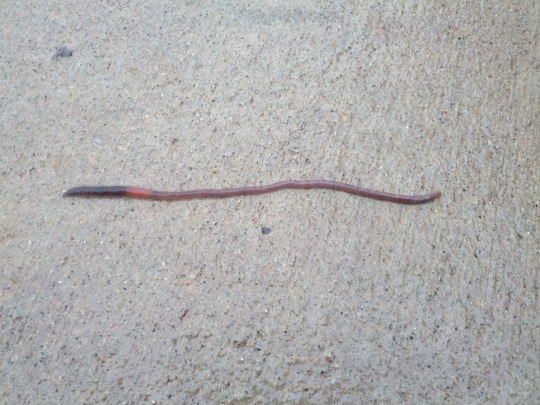
Wow. Fascinating.
Let’s be honest: earthworms aren’t the most exciting animals, to put it mildly. It’s truly difficult to imagine any more generic a creature than a tube of pasty and easily smearable flesh writhing on wet pavement after a light rain.
However, you might want to be careful when talking trash about earthworms and their fellow annelids. These pathetic all-organic homegrown noodles are essential to the circle of matter, and if they get fed up with your disrespectful shit they can just up and ditch the whole detritivorous routine, leaving you, and you personally, to literally eat dirt in their place. Be respectful to earthworms because they deal with all of the shit you don’t want to deal with, both metaphorically and in a literal sense.
But if that isn’t enough to convince you that you shouldn’t diss earthworms (in which case you’re probably an asshole to begin with), consider the following: if they can’t take more of your racist bull, they can tell on you to their big strong cousin. And pray to whatever transcendent being(s) you believe in that doesn’t happen. You do not want that to go down.
Why?
Simple.
Turns out, the ranks of the annelids apparently include the fucking Sarlacc.

*unholy screaming*
Meet the bobbit worm (Eunice aphroditois), the newest resident of your recurring nightmares. Who knew that the cousin of the lowly earthworm is a vicious mashup of one of those bendy rainbow pencils and Shai-Hulud that also happens to eat happy thoughts for breakfast? Standing at a maximum length of roughly three goddamn meters, this lethal length of rope will shear anything with the balls and/or the stupidity to approach it in half and look fabulous with its iridescent cuticle the whole time. That is no exaggeration, as you will soon come to see.
This terrible killer rainbow was discovered in 1788 by a German naturalist called Peter Simon Pallas. Imagine hopping on a boat in the late 18th century, in a time when most people still believed in the existence of a good and loving God, and finding this. Imagine his reaction.
Actually, you don’t have to, because we have his portrait and you can see his empty-eyed stare shining through. “Scarred for life” doesn’t even begin covering this bullshit.

Seriously, look into his eyes. Dude’s dead inside.
Sweet lord have mercy. This guy is the real reason why you don’t talk shit about annelids. You can boast about being “the most intelligent creature on Earth” and “the crown of creation” and blah blah blah. Fat load of good it’s gonna do ya against a 10-feet-long rainbow death worm with spring-loaded jagged mandibles quite literally the size of your middle fingers.
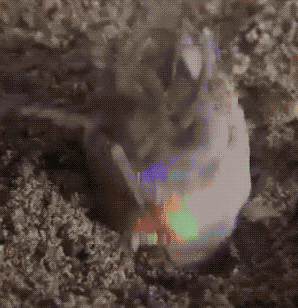
Crown this.
And guess what - that worm is fucking pissed at you. You talked trash about its phylum and now you’ll get what’s coming to you. Next time you’ll think twice before you try talking down on annelids.
To better put in perspective why you should soil your pants in fear at this prospect, let’s review the bobbit worm’s life and times, as well as its lovely feeding habits.
Oh boy!

This will be fun.
So, the bobbit worm basically comes to be from the worm jizz and eggs floating around in the ocean. (Keep that in mind next time you go for a nice refreshing swim on the ocean beach.) The fertilized eggs hatch into microscopic little specks called trochophore larvae, which then drift around in the oceanic currents as plankton like a bunch of lazy shits. Fairly humble beginnings for what will soon become the beast that is the bobbit worm. It’s a bit like how Darth Vader used to be a slave on a backwater desert planet as a kid.
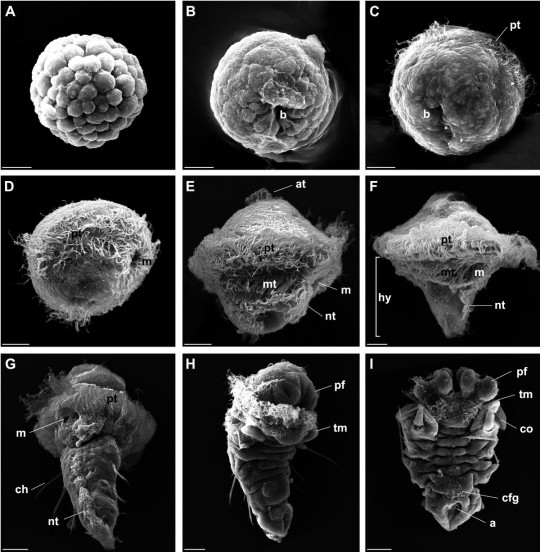
Note: this isn’t a bobbit worm trochophore, but that of another polychaete worm (Pomatoceros lamarckii), used here for demonstration. Anyway, they’re difficult to tell apart but one hatches into a harmless tube-building worm and the other a ravenous ten-feet-long predator with a pair of garden shears for a face. Polychaete larvae are like Kinder eggs, Russian roulette edition.
After growing out of its larval stage, a whole lot of completely uninteresting shit happens (mostly the gaining of additional segments), ending with a small mature worm that embeds itself into the seabed in a sufficiently warm and sunny part of the ocean.
What follows next is something right out of Return of the Jedi. What, you thought I was kidding about the Sarlacc?
The bobbit worm spends all day laying low in the seabed, waiting silently, with only the tip of its head sticking out of the sediment. Said head comes equipped with five chemoreceptory tendrils, allowing the worm to “taste” the water around itself. This comes in handy, seeing as it is completely fucking blind and the thought of growing eyes never even crossed it’s mind (which is actually fairly complex for an annelid). It’s like one of those blind sword masters from wuxia movies, except it’s a terrifying giant worm instead.
Aaaaaanyway! If the worm senses anything that “smells” edible, it correctly deduces that it is, in fact, edible. Which logically means that something was stupid enough to approach it without hightailing it out there. Therefore, it becomes a one-worm Darwin Award Committee and does this.

Steppin’ on the beach, do do do doOOOAAAAAARGH
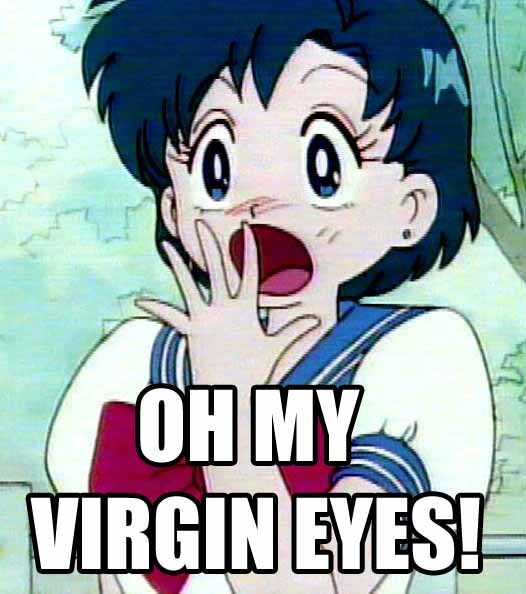
You know, the longer this article gets, the less it feels like this is biology and the more it feels like I’m writing some sort of weird Dune fanfiction.
I feel like I should note that the bobbit worm’s definition of “edible” is amazingly flexible. This fucker will eat anything that comes close to it’s terrifying maw. Crabs, shrimp, fish, worms - anything with or without a pulse is at risk of suddenly being snatched by a horrifying giant worm and swallowed alive to be digested into slurry. If you’re lucky, though, it will miss and only ends up cutting you in half with the sheer force of its strike, completely by accident. Sweet dreams.
Speaking of its digestion, there is absolutely nothing that it cannot break down. It has zero problems wolfing down entire animals twice its width, and one incident involving a bobbit worm sneaking into an aquarium had it shred wire traps furnished with fishing hooks to pieces, then swallowing the hooks and digesting them, followed by eating its way through 20 pounds of fishing wire. I’m pretty sure the next thing to be broken down in its gut will be human civilization.
And if there’s nothing around to eat, the bobbit worm still firmly refuses to die. It will sustain itself just fine on detritus, algae and tiny little silica-shelled plankton called diatoms who are easily some of the prettiest things in the ocean.

It eats pure aesthetic and turns it into rainbow cuticle and mandibles that can shred any fish to ribbons. The bobbit worm is truly the pastel goth of the ocean.
They also have a nasty habit of occasionally burrowing into rocks when young, and ending up in aquariums in secret. There, being the insidious little assholes that they are, they bury themselves into the sediment and secretly start to munch upon the dumbass utopian fish society inside the aquarium, growing from angry shoelace to technicolor abomination in the process. Often it takes years to notice the bobbit worm hanging out in your aquarium, which is a pretty big feat. Imagine if you had to stay concealed in an glass-walled aquarium for years... while being three to ten feet long and covered in garish rainbow color. This guy could effortlessly drive Naruto out of the colorful ninja business. Enjoy your paranoia next time you buy live rocks for your aquarium.

In D&D, the bobbit worm multiclasses as assassin and barbarian.
Now I hope you understand that being a fish is akin to cosmic horror. Any moment you might be cruelly snatched out of existence by a being that is outside your generally accepted reality (the water) and also happens to be shit-your-pants terrifying and even have tentacles to round out the Lovecraft aesthetic. And they are covered in bristles that cause permanent numbness, just by the way. Just in case they weren’t horrifying enough, Mama Nature’s got you covered.
Oh, and one last thing: they are found in all three oceans.
So anyway, how’s planning that seaside vacation going? Have fun!
Sources:
Encyclopedia of Life (EoL)
Echinoblog
Global Biotic Interactions (GloBI)
Ocean Biogeographic Information System (OBIS)
SCHULZE, Anja. The Bobbit worm dilemma: a case for DNA (Reply to Salazar-Vallejo et al. 2011. Giant Eunicid Polychaetes (Annelida) in shallow tropical and temperate seas. Rev. Biol. Trop. 59-4: 1463-1474)
The Daily Mail
#bestiary#bestiary revamped#polychaete#worm#annelid#predator#ridiculous jaws#sessile#colorful#nightmare fuel#too fucking large#nope#nope nope nope#so much nope#taking the nope train to fuckthatville
684 notes
·
View notes
Text
Phylum Semi-Finals

Big Spiky Things vs Little Soft Things
Pinophyta (conifers) fun fact: Giant sequoias, Sequoiadendron giganteum, can grow over 300 feet tall, 30 feet in diameter, and live for over 3,000 years. They are the world's largest trees.
Bryophyta (mosses) fun fact: Mosses in the Sphagnum genus can hold 16-26 times as much water as their dry weight.
#pinophyta#bryophyta#plant taxonomy showdown#battle of the plants#phylum round 3#phylum#plant bracket#tumblr bracket#bracket tournament#poll bracket#phylum semi-finals
150 notes
·
View notes
Text
300+ TOP ECONOMIC BOTANY Interview Questions and Answers
ECONOMIC BOTANY Interview Questions for freshers experienced :-
1. How does caffeine effect plant growth?
Minerals like potassium are often found alongside caffeine when it occurs in plant sources like coffee beans, and that could help the plant grow faster. However, the caffeine itself would be unlikely to have any affect on the plant's rate of growth.
I tested it and the plant grew at normal rate but the leaves were more wrinkly and browner
2. How do you determine if a molecule is polar or non-polar?
A polar molecule is a molecule that has a net dipole moment due to its having unsymmetrical polar bonds.
Two factors go into determining if a molecule is a polar. To determine if a molecule (or ion) is polar or non-polar, you must determine both factors.
The polarity of the individual bonds in the molecule;
The shape or geometry of the molecule
3. What is the difference between xylem and phloem?
Both xylem and phloem are vascular tissues found in a plant. Xylem is a tubular structure, which is responsible for water transport from the roots towards all of the parts of the plant. Phloem is also a tubular structure, which, on the other hand, is responsible for the transportation of food and other nutrients needed by plant.
4. What is a burette and how is it used?
A burette is a uniform-bore glass tube with fine gradations and a stopcock at the bottom, used especially in laboratory procedures for accurate fluid dispensing and measurement.
The burette is commonly used in titrations to measure precisely how much liquid is used. A burette is simultaneously occupied by the presences of a liquid measuring and transferring this derailment.
5. What is a characteristic feature of acarrier protein in a plasma membrane?
Carrier proteins are globular proteins which are specific it their action and thus regulate the entry and exit of particles into the cell. They help in the conduction of ionic substances and polar substances
6. What are living and nonliving reservoirs?
Viruses are both living as well as non-living. They have reservoirs of genes. A single nucleotide is a unit of gene. Viral genes make use of host raw material (non-living elements/organic moieties/ water etc.,) including elements to synthesize organic molecules or macromolecules. Subsequently, viruses replicate themselves thereby reproduce within the living cells. On crystallization, they become non-living and can stay in this state for years until they enter again into a living host to multiply. Certain plant viruses are transmitted to the progeny through seeds. Viruses evolve as any other living being. Therefore, now virus names are written in italics like binomial/trinomial names similar to scientific name of any other living organism i.e. Tobacco mosaicvirus (read as italic).
7. What are analogies for centrioles?
A Centriole is like a straw because they both are tubesthat let things get from one end to the other end.
The centriole has a round look to it because it is made from nine triplets of microtubules that make a straw-like (as said above) look.
8. What is an analogy for a smooth endoplasmic reticulum?
Endoplasmic reticulum (ER) is like a manufacturing plant, like a factory, where proteins and lipids are made. This is also where things are packaged into boxed and sent off to different places. In the cell the smooth ER is a network of membrane bound bodies which lack ribosomes (the molecules used in protein synthesis) and its primary function is to modify, encapsulate and transport newly synthesized proteins and lipids which will be secreted or remain in the cytoplasm as membrane bound vesicles. The smooth ER can also be compared to a highway, or a protein and lipid highway, if you will. It is sometimes called the transitional ER because it contains exit sites from which transport vesicles carrying these proteins and lipids bud off for transport to the Golgi apparatus. It is usually prominent in cells that specialize in lipidmetabolism and synthesis.
9. Why do organisms live in certain places?
Think of that, the temperature difference in the desert is huge. So in order to survive, the cactus plant reduces heat gain and heat loss as well as water loss. (E.g. narrow pin shaped leaves, long extensive roots)
10. Who created the two-part naming system used in biology?
The scientific naming system that is used worldwide today was first devised by Swedish naturalist Carl Linnaeus in 1737. He proposed a two-part naming system, which classifies every living organism with a string of Latin and Greek identifiers. Full names are devised starting with kingdom and extending downward through phylum, subphylum, class, order, family, genus and species. The two-part name, or binomial name, consists of the genus and species of the organism and used to prevent the confusion that may arise with common names.

ECONOMIC BOTANY Interview Questions
11. How does the odor of flower petals help pollination?
The purpose of the perfume is to attract a pollinator - insect, bat, bird or whatever. The reward for the pollinator is a meal of nectar, which is produced by the flower.
12. What is an analogy for microtubules?
Microtubules have two main functions in cells and in doing so act like a skeleton as well as like railroadtracks. Microtubules are the main structural component of the cytoskeleton in cells, which provides the cell with structure and rigidity and determines the shape of the cell. They also serve to transport vesicles and proteinswithin the cytoplasm through transport proteins called kinesins and dyneins, which act much like railroad cars.
13. What is an analogy for a smooth endoplasmic reticulum?
Endoplasmic reticulum (ER) is like a manufacturing plant, like a factory, where proteins and lipids are made. This is also where things are packaged into boxed and sent off to different places. In the cell the smooth ER is a network of membrane bound bodies which lack ribosomes (the molecules used in protein synthesis) and its primary function is to modify, encapsulate and transport newly synthesized proteins and lipids which will be secreted or remain in the cytoplasm as membrane bound vesicles. The smooth ER can also be compared to a highway, or a protein and lipid highway, if you will. It is sometimes called the transitional ER because it contains exit sites from which transport vesicles carrying these proteins and lipids bud off for transport to the Golgi apparatus. It is usually prominent in cells that specialize in lipid metabolism and synthesis.
14. What is the difference between an acid and a base?
Base is any thing, which has a capability to abstract a proton.
Using the simplest definition, an acid is something when added to water releases hydrogen ions (H+), also called protons. A base, or an alkali, is something that when added to water releases hydroxide (OH-) ions.
The strength of a basic (or alkaline) or acidic solution is measured using the pH scale. A pH of 7 is perfectly pure neutral water (neither acidic nor basic), and pH below 7 is acidic, and a pH above 7 is basic.
There is another definition, which says that an acid releases H+ and a bases remove H+ from water.
Thisdefinition is a bit more general than the first one above. Note that releasing OH- is the same as removing H+. This is because when OH- mixes with H+, they form neutral H2O, and so for every OH- released, one
H+ is removed by combining them into water.
The final definition of an acid and base is the most general, but the hardest to understand conceptually, and it is not always taught in high school because of this. According to this definition, acids are electron pair acceptors, and bases are electron pair donors.
15. Why does DNA twist?
If it did not twist, would you expect it to fit into the miniscule cell? As we all know, if we join all of the DNA molecules from a person's body end to end, we would get length three times the distance from the center of the earth to the sun! Therefore, DNA does not have a choice but to follow the super solenoid structure. This is also aided by the purine-pyrimidine linkages, to balance the weight of DNA components. Why pressing down on the cover slip does not remove excess water. Because of Newton's Third Law of Motion: Every action has an equal an opposite reaction and hydraulic pressure. When you press down on the cover slip, the water underneath it pushes back against you with the same force that you are pressing down on it. If you want to get the water to moveout from under the cover slip, you need to direct it to the side. One way to do this is to lift an edge and break the suction, then set it back down on one edge first to let the water run out, then press it down. This creates a side motion so the water does not push straight up into the cover slip, but pushes at an angle, which allows it to run out.
ECONOMIC BOTANY Questions and Answers pdf Download ::
Read the full article
0 notes
Photo
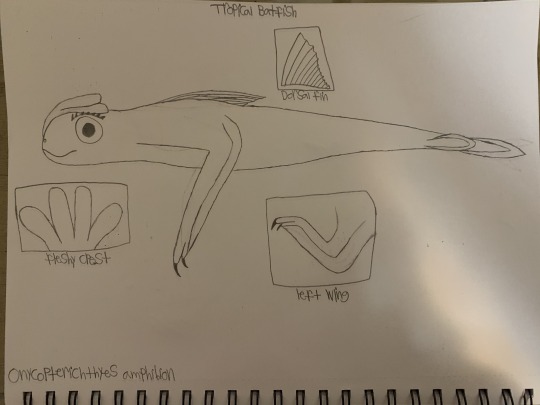
Tropical Batfish
Kingdom: Animalia
Phylum: Xenozoa
Subphylum: Diopitca
Class: Pseudoamphibia
Order: Pterichythoidea
Family: Onycopterichthyidae
Genus: Onycopterichthyes
Species: O. amphibion (”claw-winged fish of both kinds of life”)
Information: the Tropical Batfish is perhaps one of the more bizarre fish-like creatures found in Gracilis’s tropical seas. Around a foot in length, it is a small to medium-sized oceanic omnivore. However, there’s a twist: it can also live outside the water. In the event that it needs to escape a predator, the Tropical Batfish with actually thrust itself out of the water and use its long arms as wings, being able to both use powered flight and gliding to reach safety. In addition, it will also leave the water for food, flying inland in search of it. The large fin on its back can be used like a sail to help steer it in different directions. The claws on its fingers allow it to adhere to vertical surfaces, such as tree trunks. Though the Tropical Batfish does not technically have lungs, it can breathe air through modified gills like a crustacean, where, as long as its gills are kept moist, it can stay on land for extended periods. The fleshy crest on its head is used for long-distance communication between individuals, while the short spines on its eyebrows are used for protection against predation. The Tropical Baths possesses few teeth, with the only teeth it does have being four, small, rounded-out ones. After storms, it is uncommon for large numbers of these creatures to be blown several miles inland, where, out of their element, they become easy pickings for opportunistic predators. Their skin is purple in color with a blue-colored streak running down either flank. Many Plains-Folk tribes that live near the sea harvest them for food. Final assessment: could be useful for domestication, further research required.
0 notes
Text
Last year, I wrote a post on some wasps and bees I’ve found in my garden over the nine years I’d lived here. This is the second installment of the Garden Insects series, on butterflies & moths and their larvae. Future posts will cover flies, dragonflies, ants, beetles, grasshoppers, cicadas, and other bugs — some “true” bugs and some not. Possibly even worms and slugs, though they are not insects, or even in the same phylum as insects. Speaking of phylum …
_________________
SIDEBAR: The taxonomy of the insect world, briefly.
Insects are a CLASS in terms of taxonomy, within the PHYLUM called Arthropoda that’s part of the overarching KINGDOM Animalia, which contains about 2.2 million animal species, So yes, all insects are animals, though people often dispute this in casual conversation and social media.
Depending on how a phylum is determined (including whether only extant (non-extinct) animals are included or not), there are anywhere from 5 to 36 phyla in the animal kingdom; usually lists show 7 or 9 phyla, such as this one from a Yale University course that lists 9 phyla, the first 6 of which contain animals that live only in water or mud: Porifera (Sponges), Cnidaria (Jellyfish, Coral, Sea Anemones), Mollusca (Snails, Slugs, Octopus), Echinodermata (Starfish, Sand Dollar, Sea Cucumber, Sea Urchin), Annelida (Segment Worms, Leeches), Platyhelminthes (Flatworms), Nematoda (Nematodes, Roundworms, Earthworms), Chordata (everything with a backbone, so all Birds, Reptiles, Fishes, Amphibians and Mammals, including humans), and finally, Arthropoda (Insects, Spiders, Scorpions, Millipedes, Crustaceans).
This sortable list on Wikipedia, similar to a BBC Earth list, contains 35 phyla, but often many of these are considered a sub-phylum of a more encompassing phylum. Here’s a site that lists 21 phyla, while the Tree of Life project lists just 6: Porifera and Cnidaria, as above in the list of nine, but then none of the other seven, instead adding to and replacing them with Placozoa (extremely simple animals up to 3mm in size made up of only 4 cell types; only 2 species have ever been described), Ctenophora (comb-jellies), Myxoza (several-celled parasitic microscopic organisms) and the giant group of Bilateria, which includes all the vertebrates plus arthropods, molluscs, worms, and more!
Categorising life is complicated.
And don’t get me started on the top level of life Kingdoms (or Domains or Empires):
“In summary, today there are several competing top classifications of life:
The three-domain system of Carl Woese, with top-level groupings of Archaea, Eubacteria, and Eukaryota domains
The two-empire system, with top-level groupings of Prokaryota (or Monera) and Eukaryota empires
The five-kingdom system with top-level groupings of Monera, Protista, Fungi, Plantae, and Animalia
The six-kingdom system with top-level groupings of Archaebacteria, Monera, Protista, Fungi, Plantae, and Animalia
Overall, the majority of biologists accept the domain system, but a large minority uses the five-kingdom method.” (from New World Encyclopedia: Taxonomy)
So, leaving the weeds to recap for today’s posting on insects, insects comprise one CLASS (called Insecta) of the PHYLUM Arthropoda, which also contains, in other classes (not Insecta) such animals as arachnids (spiders, scorpions, ticks, mites, et al.), crustaceans, millipedes and centipedes, horseshoe crabs, and so on.
Within the CLASS Insecta are about 30 ORDERS, including our focus today, Lepidoptera (butterflies and moths), plus:
Hymenoptera: ants, bees, wasps, sawflies … it’s a big group
Hemiptera: all true bugs, within three sub-orders: Heteroptera – bugs; Auchenorrhyncha – cicadas, leafhoppers; and Sternorrhyncha – aphids, scales. True bugs are insects that have two pairs of wings and hypodermic-needle-like mouthparts, and they all undergo incomplete metamorphosis, with their young hatching from eggs to become nymphs, which are miniature versions of the adult bug minus the wings.
Diptera: flies — but not all insects with the word “fly” in their names; also mosquitoes
Coleoptera: beetles
Orthoptera: katydids, grasshoppers, crickets
Odonata: dragonflies & damselflies, each in its own sub-order
Trichoptera: caddisflies
Ephemeroptera “lasting a day”: mayflies
Mantodea “like a prophet”: mantises
Phasmatodea “like a ghost”: walking sticks
… and a couple dozen more. (Check out Bugguide’s intro or the list here.)
_________________ END OF SIDEBAR
*
Now on to the butterflies and moths, and their larva, i.e., caterpillars. (All photos from my yard this year unless noted otherwise.)
What’s interesting to me is that I commonly see both the larval and adult forms of some butterfly species, such as monarch butterflies and caterpillars (Danaus plexippus), while I typically see only either the larval or the adult form of others, such as black swallowtail butterflies (Papilio polyxenes); I’ve seen a handful of black swallowtail caterpillars in my yard this year and no adults, though I’ve seen a few flying around town. Same thing with yellow swallowtail butterflies, either Eastern tiger, Papilio glaucus or Canadian tiger, Papilio canadensis — I’m never sure which; I see lots of adults and no caterpillars, which are darned cute.
(Male) monarch butterfly, 12 Aug 2019; monarch caterpillar, 25 July 2019:
I like this monarch-in-flight photo that the motion camera caught on 2 Aug. 2019.

I’ve had two chrysalises hatch successful adult monarch butterflies in the garden, and I’ve seen at least three dozen monarch caterpillars on the milkweed plants (Asclepias syriaca and A. incarnata) since mid-July, including one large one today, which is getting to be too late for pupating, hatching, and flying to Mexico.
*
Black swallowtail butterfly, in the garden in Sept. 2015 ; black swallowtail caterpillar, 17 Sept 2019:
I’m still seeing black swallowtail caterpillars on dill in the garden now, too.
*
These are both Eastern yellow tiger swallowtails, both photographed on 25 July 2019; the one on the left is a female (more blue), the one on the right a male. I don’t have any photos of yellow tiger caterpillars, never having noticed one, but here’s one online — cute, right? Kind of like a spicebush caterpillar.
*
Similarly with MOTHS: I’ve seen loads of tussock moth caterpillars this year — it’s been a banner year for them in the northeast — but no adult tussock moths (they are beige and somewhat nondescript):

spotted tussock moth caterpillar (Lophocampa maculata) foreground, and looks like a banded tussock moth caterpillar (Halysidota tessellaris) in the background – 11 Sept 2019
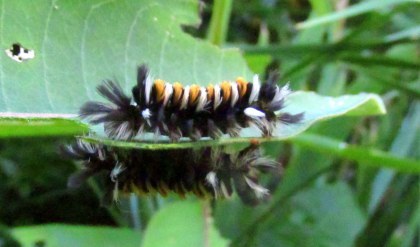
milkweed tussock moth caterpillar (Euchaetes egle), on milkweed – 25 Aug 2019

banded tussock moth caterpillar (Halysidota tessellaris) – 13 Aug 2019
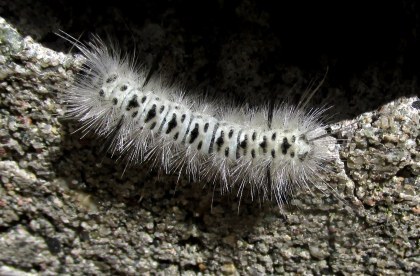
hickory tussock moth caterpillar (Lophocampa caryae) – 11 Aug 2019
*
I’m likewise seeing a fair number of woolybears, those fuzzy caterpillars of the banded woolybear moth aka Isabella tiger moth, Pyrrharctia isabella or of the yellow woolybear moth, aka Virginian tiger moth, Spilosoma virginica, but I’ve not noticed any actual moths of the species:

I think this is a Yellow Woolybear Moth caterpillar aka Virginian Tiger Moth (Spilosoma virginica), on the garden hose, 12 Aug 2019

And this is another Virginian Tiger Moth (Spilosoma virginica), seen not in my garden but at Laudholm Farm in Wells, Maine on 9 Sept. Quite different in appearance.

Here’s a banded woolybear moth caterpillar aka Isabella tiger caterpillar (Pyrrharctia isabella), taken nearby my home in New Hampshire last year, Oct. 2018; I’ve seen some this year but haven’t been able to get photos.
Obviously, I’m probably just not noticing or recognising the moths in their adult forms (they tend to blend), and I’m not out at night prowling around or leaving lights on to lure them, but the swallowtail situation is more perplexing to me, as they are fairly striking in both forms.
*
A new one for me this year has been the American dagger moth caterpillar (Acronicta americana). I first saw it coiled in a round disk on the patio (27 July) and wasn’t sure it was even an animal.

But folks on Facebook insect pages assured me it was. I’ve since seen the same species in other spots in the yard. Here’s a bedraggled one on a peach, 3 Sept.:

Here’s another, all curled up in a small Japanese maple (‘Bloodgood’) tree a few days ago.

There’ve been other dagger moth caterpillars around as well, including these larvae of the splendid dagger moth (Acronicta superans), both seen on 19 Aug. 2019 but at least 15 yards from each other, the first on a purple leaf sand cherry (Prunus × cistena) and the second on the shed.


I saw this one on a sidewalk in town on 16 Aug. 2019; it’s a fingered dagger moth caterpillar.

fingered dagger moth (Acronicta dactylina) caterpillar, 16 Aug. 2019
And this one also in town, on 13 Sept. 2019, a yellow-haired dagger moth (Acronicta impleta) caterpillar:
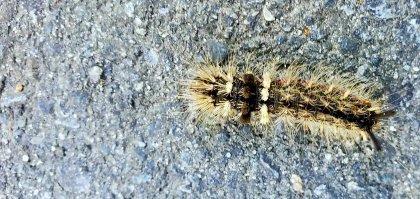
*
A couple more moth larva seen locally this summer:

rosy maple moth (Dryocampa rubicunda) caterpillar, 22 Aug. 2019, on a local trail

a polyphemus moth (Antheraea polyphemus) caterpillar ready to pupate (this is why it’s orange and not green), 26 Aug 2019, on a local sidewalk and heading toward the road (I moved it)
*
The clymene moth (Haploa clymene), a kind of tiger moth, is a very distinguishable species that I seem to see about once a summer on the lawn. This photo was taken on 30 July 2019. I’ve never noticed it in its larval form, which somewhat resembles a webworm.

*
This ipsilon dart moth was a new one for me, and I might not have noticed it on the ground if it hadn’t moved a bit. I posted it two two Facebook insect ID groups and I’m amazed that with the sunlight glaring on this specimen, two people in two separate groups actually recognised it!

Agrotis ipsilon (Ipsilon dart) moth, 8 Sept 2019
*
Another new one for me is this tiny boldly marked Archips moth (Archips dissitana), seen on Clintonia borealis (blue-bead lily) alongside a local trail, 28 July 2019; sorry it’s a bit blurry:
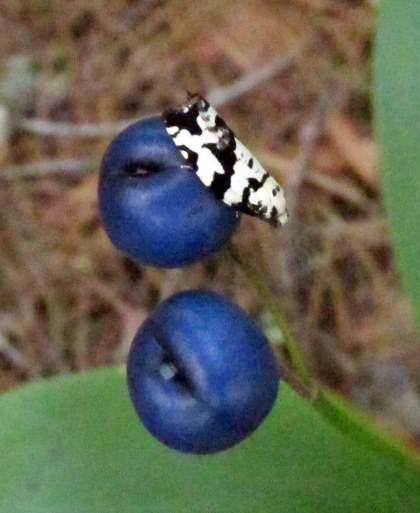
boldy marked Archips moth (Archips dissitana) on Clintonia bead, Sutton, NH, 28 July 2019
*
This giant luna moth (Actias luna) was a new and serendipitous sighting for me as well!

luna moth (Actias luna) on a local bakery storefront, 30 June 2019
*
Two moths that look more like tiny hummingbirds are the clearwing moths: the hummingbird clearwing (Hemaris thysbe) that’s olive and reddish-brown, and the snowberry clearwing (Hemaris diffinis), which is black and yellow. We’ve had many of both here all summer.
This is the hummingbird clearwing (Hemaris thysbe), on bee balm (monarda) and buddleia ‘Ellen’s Blue’:
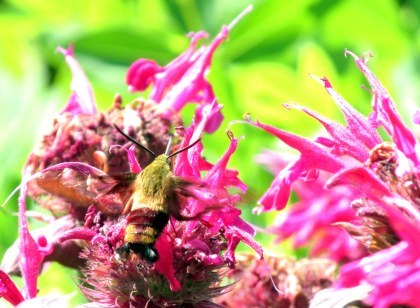

And this is the snowberry clearwing (Hemaris diffinis), on buddleia ‘Ellen’s Blue’:


I love the curled proboscis in the second photo.
*
BACK TO BUTTERFLIES
Besides the monarch and yellow swallowtails, above, another butterfly showing up here in droves this season is the painted lady (Vanessa cardui). I can’t decide if it’s more beautiful from the side or with wings open. (Shown here, on 10&11 Sept.) on buddleia, sedum, and Joe Pye weed.) There are still a lot of them around even now.
I guess I like the side the best!
Oddly, a naturalist writer near Keene, NH, about 50 miles southwest, said last week that he hasn’t seen any painted ladies this summer!
We’ve also had a fair number of American lady butterflies (Vanessa virginiensis) this season. They have only two big circles on the side of the wing, and the markings on their hindwings are quite different, too. (Shown here, from 24 July – 24 Aug,, on clethra ‘Ruby Spice’ and echinacea)
And look, I actually managed to find the larval form of the American lady!

*
I haven’t seen many white admiral butterflies (Limenitis arthemis) in the garden this year, but was able to photograph the tattered varmint on buddleia on one of the few days when I did (11 Sept. 2019). It’s a strange species, having two very different forms that used to (understandably) be considered two separate species; one is a red-spotted purple form, and the other is the “white” version, which is really black, white, blue, and reddish.

Last year I spotted one on a rotting peach (4 Sept 2018).
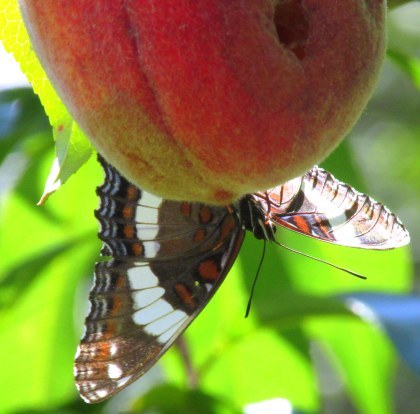
And here’s the red-spotted purple version on buddleia in the garden, seven years ago, on 1 Aug. 2012
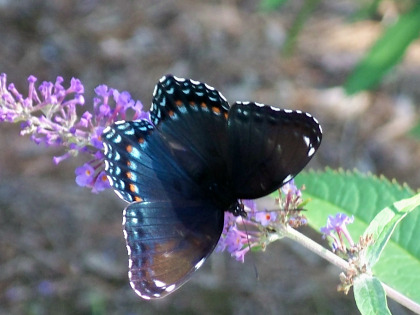
*
Early in the season we had some small fritillaries, which are so common in the south (Jekyll island, GA, for instance – especially gulf fritillaries) but not as much up here. This one was seen on 24 July 2019. I think it’s a great spangled fritillary (Speyeria cybele). We also have an aphrodite fritillary (Speyeria aphrodite) here, somewhat smaller but otherwise I can’t tell them apart.

*
These are all skippers, a small butterfly; I don’t know their species (there are almost 40 species of skippers in New Hampshire). There were a bunch around the yard in July.

27 July 2019

11 Aug. 2019 on echinacea … maybe Peck’s skipper (Polites peckius)
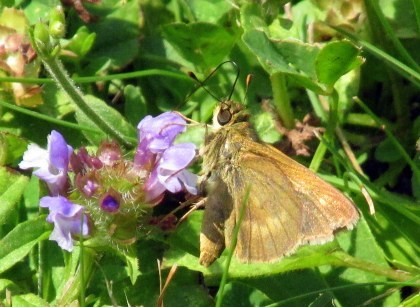
27 July 2019 on self-heal in the lawn
*
I saw a few duskywing butterflies (genus Erynnis, a kind of skipper) in July and August, including this one (I think):

duskywing butterfly (Erynnis spp) on echinacea, 3 Aug. 2019
There are 12 or so species of duskywing, sootywing, and cloudywing butterflies in New Hampshire and they all look kind of alike.
*
Here are a few more butterflies I’ve seen this year in places that aren’t my garden.
This one wasn’t even in New Hampshire, but I rarely see an Eastern comma (Polygona comma) butterfly:

Eastern comma butterfly (Polygonia comma), Laudholm Farms in Wells, Maine, 9 Sept. 2019
A couple of sightings of the common buckeye butterfly (Junonia coenia).
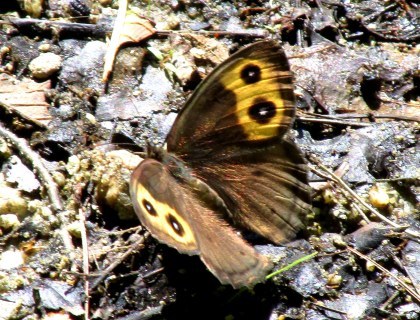
New London, NH, 26 Aug. 2019
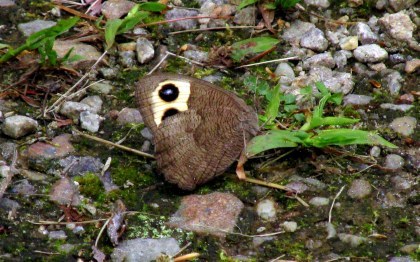
Great Bay NWR, Newington, NH, 23 Aug. 2019
*
A northern spring azure (Celastrina lucia) — I see many azures (both spring and summer species) but they are very small and very fast, hard to capture on film.
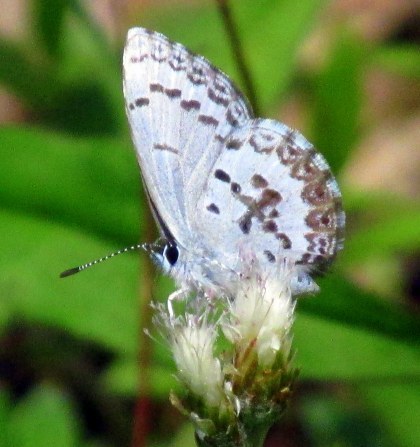
northern spring azure butterfly (Celastrina lucia), 25 May 2019
*
A crescent butterfly, probably a northern crescent (Phyciodes cocyta), but possibly a pearl crescent (Phyciodes tharos).

crescent butterfly, Enfield, NH, 19 June 2019. There are three kinds in NH — tawny, northern, and pearl; I think this is the northern crescent (Phyciodes cocyta).
*
A clouded sulphur (Colias philodice) butterfly, at The Fells Estate in Newbury, NH, 22 Sept. 2019, on pink asters:

*
This eyed brown (Satyrodes eurydice) butterfly was a new one for me. The common names — eyed brown and marsh eyed brown — just sounds incomplete to me. There’s also a Satyrodes appalachia, Appalachian brown or woods eyed brown, which is very similar (they were previously thought to be the same species), and it’s possible that’s what this is, but people who know more than I do about these things identified it as S. eurydice.
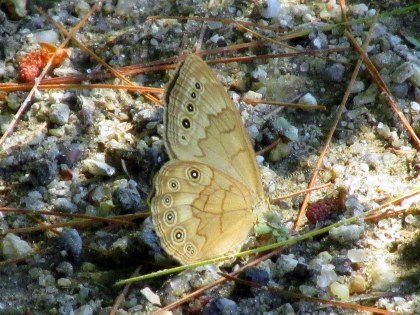
Satyrodes eurydice (Eyed Brown/Marsh Eyed Brown butterfly), Sutton, NH, 5 July 2019
*
Finally, these butterflies are fairly common here but I haven’t taken any photos of them (or even noticed a copper) yet this year, so I’m including garden photos from previous years.

cabbage white (Pieris rapae) butterfly on ‘Bluebird’ Aster laevis, 27 Sept. 2018.
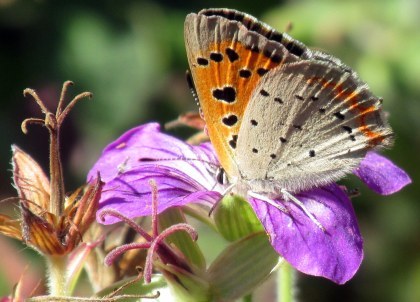
American copper (Lycaena phlaeas) butterfly on geranium, 18 Sept. 2015
I’ve never seen a mourning cloak (Nymphalis antiopa) in my garden but I see them along some trails in early spring; their our earliest butterflies. I actually saw one this spring but couldn’t get a good shot of it, so here’s a mourning cloak along a trail in Concord, NH, 23 April 2016.
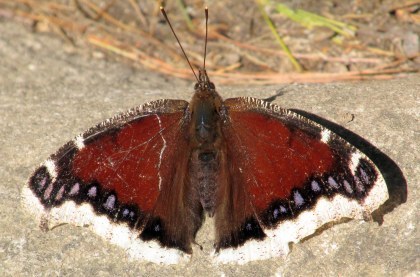
*
Sources:
The Animal Kingdom, by Joe Lewis, Yale-New Haven Teachers Institute
Ask a Biologist: True Bugs, by Adam Dolezal and Page Baluch
Phylogenic List of Insect Orders
Hummingird Moth (Mass Audubon)
Side-by-Side American Lady and Painted Lady butterflies (Mass. Butterfly Club)
Wildlife Journal Junior – NH PBS – list of insects (mostly butterflies) in NH
Featured image: monarch butterfly drying wings after eclosing, 11 Sept. 2019.
Garden Insects: Butterflies, Moths, and Caterpillars (Lepidoptera) Last year, I wrote a post on some wasps and bees I've found in my garden over the nine years I'd lived here.
#American lady#butterflies#caterpillars#clearwing moths#dagger moth#fritillary#insects#larva#lepidoptera#monarch#moths#painted lady#skipper#swallowtail#taxonomy#tiger moth#tussock moths
0 notes
Photo

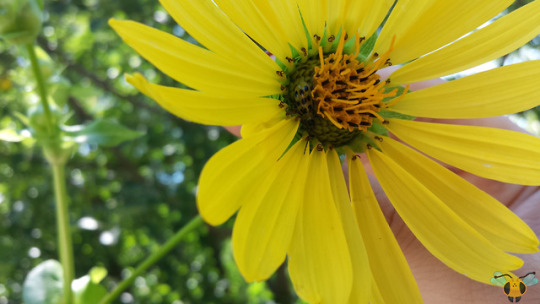
Spotted Cucumber Beetle - Diabrotica undecimpunctata
Look closely at this flower, right at its center; hidden ever so well on the flower moves a glossy yellow Leaf Beetle with black spots. It’s quite adorable as far as Beetles go and has a very rounded, appealing appearance, almost like a spotted jellybean. While it may look pleasant, this Beetle has a reputation as an agricultural pest! As their name suggests, they fancy cucumber plants but also enjoy soy, beans and corn. The adults target the leaves of the plant, while the (more worm-like) larvae attack the roots of the plant after hatching in mid-spring, which in turns leads to crop damage. High Park sounds like the perfect environment for them given the amount of vegetation, though they’re unlikely to find cultivated plants in the wild). I always try to find at least one of these Beetles year after year, but I never find more than a few. If High Park begins to see too many of , I know we’ll be in trouble. Hopefully the predatory insects of High Park can help keep their numbers in check. The grubs can be vulnerable to predators given their soft bodies.
In addition to the Spotted Cucumber Beetle, there is also a Striped Cucumber Beetle (Acalymma vittatum). Though similar in name, they branch off from each other after the tribe classification. To clarify, the ordering is this: Domain > Kingdom > Phylum > Class > Order > Family > (Tribe >) Genus > Species. It’s all a bit technical, but the system allows for in-depth classification, especially if you take into account the use of “super-” and “sub-” prefixes for some of these classifications. Anyways, the point I was getting at is that the Spotted and Striped Cucumber Beetles are sorted together up their Tribe grouping: Luperini. From there, they diverge into different genera and specie classification based on their characteristics. We may dive into this in future posts, but for now if you’re looking for the Striped Beetle, the stripes run from the front to the back and the shell is yellow and black in color with texture (it’s not a smooth shell). As well, the Striped Beetle is just as much an agricultural pest as the Spotted Cucumber Beetle (This blog finally has a specimen, click here to see it)
Pictures were taken on August 19, 2016 in High Park with a Samsung Galaxy S4
#jonny’s insect catalogue#insect#beetle#spotted cucumber beetle#leaf beetle#coleoptera#toronto#high park#august2016#2016#ontario insect#entomology#nature#invertebrates
0 notes
Text
Rio Rancho student wins 2019 New Mexico Spelling Bee
Eliana Juarez of Mountain View Middle School in Rio Rancho reacts after correctly spelling the final word to win the 2019 Albuquerque Journal New Mexico Spelling Bee on Saturday. (Jim Thompson/Albuquerque Journal)
ALBUQUERQUE, N.M. — Hard work and long hours of studying paid off for 14-year-old Eliana Juarez, who took first place in the 2019 Albuquerque Journal New Mexico Spelling Bee.
The eighth-grader from Mountain View Middle School in Rio Rancho beat out 51 other elementary and middle school students in the course of the four-and-a-half-hour event held at Sandia Preparatory School in Albuquerque on Saturday.
Juarez, rocking back-and-forth on her toes and heels, won the 72nd annual competition by correctly spelling the championship word “tardigrade,” which Merriam-Webster defines as “any of a phylum of microscopic invertebrates with four pairs of stout legs that live usually in water or damp moss.”
Juarez will now head to the Scripps National Spelling Bee outside of Washington, D.C., at the end of May.
“I’m really excited for nationals,” she said,” and I’m going to work really hard for that.”
Takuys Ii looks up to the microphone as he spells during the 2019 New Mexico Spelling Bee at Sandia Preparatory School. (Jim Thompson/Albuquerque Journal)
This wasn’t the first competition for Juarez. In addition to winning her school and district spelling bees, she placed second in the 2018 New Mexico Spelling Bee, and has been competing in bees since the sixth grade.
Since winning the Rio Rancho district bee on Jan. 18, Juarez said she has been practicing intensely and studying “every chance I could get.”
“It’s extremely stressful, very high pressure, because the smallest mistake will just disqualify you for the next levels,” she said.
Juarez is the first student from Rio Rancho to compete in the national competition.
“I’m really happy that I’m going to be able to represent my school and the district,” she said.
“We’re very excited for her. She’ll be a terrific representative for the state,” said Kim Vasely, co-coordinator of the Rio Rancho spelling bee.
Beyond being a spelling whiz, Juarez hopes to someday work in the medical profession, even perhaps becoming a surgeon.
The competition on Saturday was stiff, and four hours after the bee began, only six students remained.
Steve Johnson of Datil makes a face after spelling a word during 2019 Albuquerque Journal New Mexico Spelling Bee on Saturday (Jim Thompson/Albuquerque Journal)
Dhruv Grandhe, 12, placed second, but ultimately lost out to the word “alimentary,” which means relating to nourishment or sustenance, in the 16th round. He spelled it “alamentory.”
Grandhe, a sixth-grader at the Albuquerque Institute for Mathematics and Science, or AIMS, said he practiced for an hour and a half every night.
This was the third state spelling bee he has competed in, but Grandhe said that he still gets nervous and worries about making a small mistake.
Dustin Parsons, 14, of Eastern Hills Christian Academy in Albuquerque and Garrick Tam, 11, were brought back after Juarez won to compete for third place. Tam, a fifth-grader at Sandia Base Elementary School, broke the tie by correctly spelling the word “ambrotype,” defined as a photographic negative on glass, backed by a dark surface.
Students from 291 schools across New Mexico competed in various competitions since August to get to the state competition, spelling bee coordinator Lynn Marie Rusaw said.
“I’m so proud of these kids because they’re so awesome,” she said.
Pictured, from left, are the top finishers at the 2019 New Mexico Spelling Bee: Dhruv Grandhe of the Albuquerque Institute for Mathematics and Science (second place), Eliana Juarez of Mountain View Middle School in Rio Rancho (first place), and Garrick Tam of Sandia Base Elementary (third place). (Jim Thompson/Albuquerque Journal)
Source Article
The post Rio Rancho student wins 2019 New Mexico Spelling Bee appeared first on CITY TUNNEL.
Learn More At: http://www.citytunneln.com/rio-rancho-student-wins-2019-new-mexico-spelling-bee/
0 notes
Photo
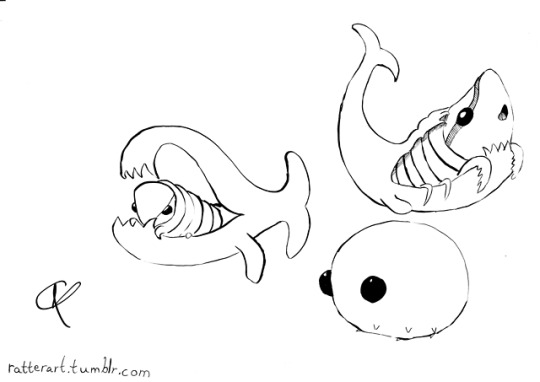
Day 24
Cymothoa exigua, member of the Arthropod phylum
I have been waiting for this one! Cymothoa exigua also known as the “fish tongue parasite” is a cool little arthropod that bites of the fish’s tongue and attaches itself as the new tongue.
I believe this would make a really cool bug pokémon. The larvae is basically the same as you can’t go wrong with a round blob. The middle stage is supposed to convey a cocoon at the same time it shows the tongue aspect of the creature. And in the final stage the parasite has completely taken over and turns into a bug/water type. It gets bug and water types moves and its ability is water absorb.
the “fish” comes from my day 11 drawing. which is a fish based of a jaw worm.
1 note
·
View note
Text
Mid-Finals Enlightenment
trying to remind myself that I have so much more than I could have ever asked for in this life. The love I have been feeling for my family is tear-jerking, and I am so excited that I am almost done with this semester so that I can spend time with my crazy friends. I am so damn stressed right now, with four finals coming up in the next three days and four closing shifts in a row at work, but I am trying not to cry or scream or freak out and have a mental breakdown. This was a really challenging semester, both school-wise and in my own personal life as well. People who I thought would be by my side forever have become absent from my life, meanwhile others who I never thought I would willingly speak to again have become close acquaintances. I am really starting to learn the importance of self-care, of letting my emotions take over sometimes, of not worrying about how much money I have or the things I own. I have also learned that I need to stop thinking so much about the future, and trying to force myself/guilt myself into finding out what I want to do as soon as possible. Similarly, I have learned that I am really really scared about my future. I have also learned that maybe I am a bit manic, and I tend to let my depression and my anxiety steer my life. I have learned a lot. the biggest thing I have learned, however, is that everything in life should be seen as a learning experience. Everything I go through, every encounter I become a part of, every time I cry, every time something does not go my way, or I get anxious, or feel alone, or don’t think that I am going to make it out of the week, etc. I stop and ask myself “what am I supposed to be learning from this? What is the universe trying to open up to me? Why am I feeling what I am feeling, and do I like it? How can I use this to become more well-rounded, more experienced, more _____?” As I am sitting here trying to memorize the anatomy of a flower and the Phylum and Class of twenty different animals, I need to remember that the stress I am under is not forever. I need to remind myself that I have been doing great so far, even if I don’t feel like I have been. I have been keeping it together, and I have been getting through it. I have been crying a lot and questioning a lot and feeling alone a lot but I am trying to remind myself that whatever I’m feeling is natural, it is instinct, and I need not to shut it out and move on but to ponder on it and embrace it. Everything is a learning experience. Everything is a learning experience. Why is the universe trying to teach me so much lately?
0 notes
Text
Provide UM.
College bike course celebrates first wedding anniversary, expands online outreach. Develop a complete registration control program that serves as a foundation for premium undergraduate education. The Rule Center, which opened up in 1978, was designed by designer Edward Stone, that also designed the New york city Museum of Modern Craft. You will have four primary and pair of optional courses and also take on a closely watched research treatise on a concern appropriate to your area from rate of interest.
In her most current phd, simmons-potter and also venture student Brian Fox checked out optical fibers sedated with erbium (Emergency room, number 68 on the periodic table) as well as ytterbium (Yb, amount 70 on the table of elements) with the objective of creating them better for laser devices and also amplifiers in space-based telecoms. Block 2:. A historical/contextual exam from the advancement from a certain ethical concept; that of private liberties.
I really hope too you'll stop by my workplace (7195F Helen C. White) or even email me if you want to make a consultation, if only to offer yourself. Trainees will certainly embark on a singular piece of work over Autumn and Spring season phrases, showing a model of their application mid-way via the project. The Old Surgical treatment, The College from Kent, Chatham Historic Dockyard, Kent, ME4 4TZ, T: +44 (0) 1634888980.
Microeconomics is worried about the practices from individual economical agents including federal governments, consumers and also companies. The secret is actually visiting be whether you can industrialise development. Phylum MOLLUSCA: features; customizations of the standard molluscan design in Polyplacophora, Gastropoda, Bivalvia, and also Cephalopoda. Assigned an other from the Academy from Social Sciences in 2015, Lecturer Youthful has been described as a one-off" whose oversights, help and also analysis have actually possessed a worldwide influence, making her a worthy champion of Moments Higher Education's first award for Outstanding Investigation Supervisor from the Year.
And over 6,000 from these are actually trainees, whose payments improve their expertise while reducing our full time payroll expenses. As a result, the element will definitely be actually valuable for students that aspire to developing their very own organisation and/or offering advancement with new item, company, job, process or organisation development in a well-known organisation.
Rodgers Collection was actually built in 1990 and named after PHYSICIAN Eric Rodgers, who was a physics instructor and also the Administrator from the Grad Institution off 1958 to 1971, and his partner Sarah Rodgers, which was a studies professor at UA. The scientific research compilation from Lloyd Venue and the engineering assortment from the Mineral Industries Structure were moved to Rodgers after the building's finalization.
5 Seconds That Basically Summarize Your gel Adventure.
Capstone certificates make it possible for trainees along with a bachelor's level to secure additional specialist capabilities as well as license. Energetic Thoughts is locateded in Washington, D.C. and possesses phases in nearly every state from the US. Follow us on Twitter and also Instagram @Active_Minds. The majority of offers are going to be made to students who accomplish levels effectively above the minimum access criteria.
Seven Indicators You love gel.
Best 5 Usual Bias Regarding gel.
Energy storing is actually a cornerstone for Minnesota: That possesses the potential to decrease our device costs, boost power framework resiliency, and even lessen greenhouse fuel emissions in our more comprehensive coal-dependent location," mentioned Ellen Anderson, supervisor from the Energy Transition Lab. In the event you loved this article and also you would want to be given more info about www.baraniboss.info i implore you to check out our internet site. Pupil duplicates, secondary school record duplicates, or scores coming from senior high school records will certainly not be allowed.
If you are actually an electronic devices as well as electrical engineering graduate wanting to enhance your abilities as well as understanding; a graduate from yet another design specialty or physical scientific research and you intend to modify industry; seeking a well rounded postgraduate certification in electronics as well as electrical engineering to boost your job customers, this program is designed for you.
0 notes